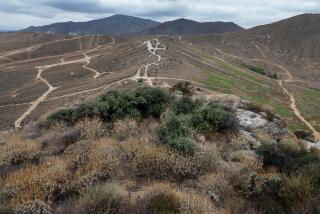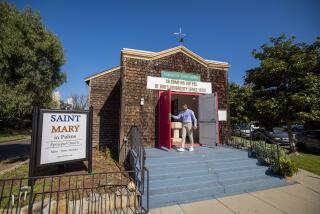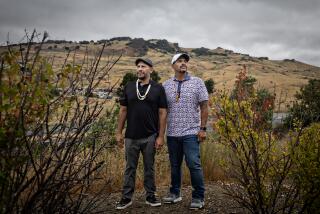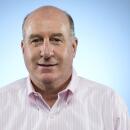Indians Urge Extra Cathedral Site Tests
- Share via
Fearing that ancient graves might be paved over once more, Native American activists Thursday urged that extra archeological testing be conducted on the proposed site of a new Roman Catholic cathedral in downtown Los Angeles.
“I have no objection to the cathedral, but don’t do it on the bones of our ancestors,” said Lillian Robles, one of several American Indian leaders who spoke at a meeting of the Los Angeles Community Redevelopment Agency.
Fragments of an ancient skull were found buried on the land in 1957 during previous trenching, according to a UCLA study. The Gabrieleno-Tongva Tribal Council warned that the property might contain more graves as well as artifacts of a Gabrieleno Indian settlement on the uplands from what is now called the Los Angeles River.
*
The tribal activists also called for a delay in preparation of the city’s environmental impact report for the Cathedral of Our Lady of the Angels, which is to be built on a 5.8-acre site between Temple and Hill streets, the Hollywood Freeway and Grand Avenue. The Roman Catholic archdiocese bought the former county-owned parking lot for $10.9 million.
CRA officials said they hope to meet next week with the American Indian leaders and allow the activists to help choose an archeological team that will monitor excavations and possibly conduct test borings.
“We are looking forward to coming up with a resolution satisfactory to everybody,” said Don Spivack, CRA deputy administrator.
However, the CRA declined to delay the environmental report, which was expected to be finalized before a groundbreaking ceremony late next month. The Riordan administration wants city agencies to help Cardinal Roger M. Mahony meet his timetable to complete the $50-million cathedral by September 2000. Designed by Spanish architect Jose Rafael Moneo, the cathedral complex would include a rectory, offices, a ceremonial central plaza, a contemplative garden and a 180-foot-high bell tower.
Sharon Cotrell said she and other Native Americans welcomed the chance to meet with city officials handling the project. “I think it sounds more hopeful than before,” she said after the meeting. Cotrell and others stressed that Native Americans did not necessarily want to block the cathedral construction but want to make sure the property is correctly explored.
“Please assist us in our efforts to document our history and cultural resources for the benefit of all Angelenos,” the tribal council urged in a statement to the CRA board. If human remains or artifacts are found, the council headquartered in San Gabriel will claim ownership and will want to determine their fate, the leaders said Monday.
CRA staffers said the discovery of a Native American graveyard is unlikely. The skull discovered in 1957 was under 11 feet of fill and soil and may have been moved there from another site in the area, they say. However, any remains or artifacts found during cathedral-related digging would be handled with respect and in accordance with state and federal laws, CRA officials said.
*
Several speakers, including some who identified themselves as Catholics, referred bitterly Thursday to the 18th century Spanish settlement of California, led by the establishment of the Roman Catholic mission system. The missionaries crushed the native cultures, Native Americans contend.
Cardinal Mahony did not attend the CRA hearing, but Msgr. Terrance Fleming, the archdiocese’s vicar general, was there. Fleming, who did not speak during the public comment period, later said he thought that the American Indian concerns could be met without delaying construction. “It is part of a process,” he said.
Monday’s hearing was the latest twist in the already complicated efforts to build a new cathedral. Originally, the archdiocese sought to demolish its current cathedral, St. Vibiana’s, and build a replacement there. Legal disputes with preservationists and financial problems in acquiring adjacent land led the cardinal to the new site by the freeway. The fate of St. Vibiana’s remains uncertain.
More to Read
Sign up for Essential California
The most important California stories and recommendations in your inbox every morning.
You may occasionally receive promotional content from the Los Angeles Times.











